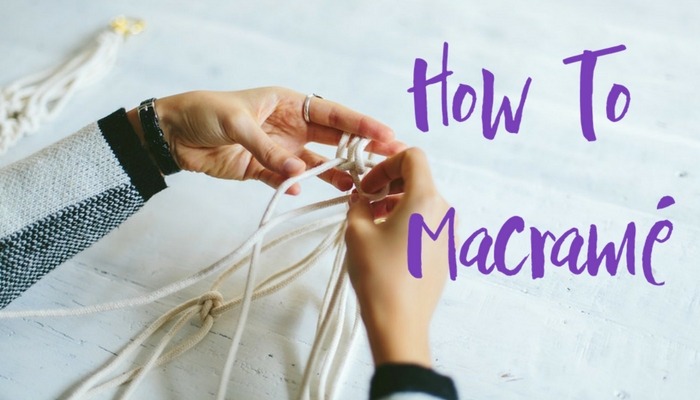Macramé is a beautiful and complex art form.
And our newest crafting obsession.
Maybe you’re looking for a new hobby, have heard about some of the beautiful things you can create, or just want to understand more about the craft. What is macramé, how does it work, and what do you need to get started?
Fear not – we’re here to break down the complicated and the simple, so you can dive into this fun new craft.
Let’s take it away…
Contents
What is Macramé?
It’s a textile art, just like crocheting and knitting.
Unlike crocheting and knitting, however, macramé products are made by knotting string or a cord with basic knots.

Photo by miracle design (CC BY-ND 2.0 licence)
The name for a knotted piece of cord is a sennit.
There are several varieties of macramé, distinguished by which knots are primarily used in the project. Cavandoli macramé, for example, is usually done entirely with the double half hitch knot.
We’ll cover the different types of knots in just a moment.
Macramé Tools and Supplies
One of the things we love about macramé is that it doesn’t require any special supplies. You just need any stick and some kind of cord or string.
This can be a pencil and some yarn for a small project, or a broom and some paracord for a larger project. You can also use fancier materials, if you’d like, but it’s best to keep it simple when you’re first starting out.
The cord or string is hung off of the stick or rod, and you make the knots in your cord while it is supported by the stick.
The finer the cord, the more detailed patterns you can create in your macramé article.
Thicker cord results in faster macramé and less finely detailed patterns.
Cord is sold and differentiated by how many individual strands it is composed of: four-ply cord, for example, is composed of four strands twisted together.
The thickness of the cord is dependent on what material it is composed of: cord made of cotton and cord made of leather are different thicknesses.
The cord you choose for your project depends on what you hope to accomplish. If you’re attempting a detailed project, like a light window covering, you’ll want a thinner, low-ply cord like cotton and a rod long enough to hold all the required cord.
If you’re using macramé to create something that’s meant for heavy use, like a plant holder, you’ll want stronger cord like jute that can handle the heavy use for both indoors and outdoors.
Getting Started: Macramé Basic Knots
There are several basic knots used to create macramé patterns and items, so getting started doesn’t require a great deal of know-how.
We definitely recommend watching videos to learn how to create these knots with various types of cord and with differing numbers of individual cords.
There are a huge number of resources on websites like YouTube that have specific examples and methods for creating these knots.
Here are a few to get you started:
Lark’s Head Knot
The lark’s head knot is a common and basic knot which is used to attach your cord to the rod.
Half Knot
Square Knot
Vertical Half Hitch
Diagonal Double Half Hitch
Horizontal Double Half Hitch
Half hitch knots can be created with various numbers of cords and different methods.
You can also use traditional braiding in making macramé pieces.
By combining knots, traditional braiding techniques, and some creativity, macramé results in beautiful but practical works of art.
How to do Macramé
The first step to learning how to macramé is learning how to read macramé patterns.
Macramé patterns, unlike other textile patterns, don’t require counting stitches or knots.
Instead, macramé patterns describe how to arrange knots and braids to result in a long thread of macramé (a sennit), and multiple threads can be combined to create a larger project.
The patterns detail individual steps for individual knots, often accompanied by pictures.
Some patterns also detail instructions for how to combine various sennits into beautiful objects; other patterns only detail how to create individual sennits. Sennits can be combined in many different ways.
Where to Find Macramé Knots and Patterns
There are many places throughout the internet to find patterns for macrame articles or clothing.
Special online communities are dedicated to exchanging patterns, finding free or cheap macramé patterns, and talking about fun projects in progress, making it a great group experience as well as an individual hobby.
Where would we crafters be without Pinterest?
There’s an absolute wealth of free macrame patterns and knots on here that are just waiting to be discovered by you.
Check out our macrame board for starters:
Macramé Subreddit
This subreddit is a community within Reddit that is focused on macramé, sharing patterns, helping beginners, constructive criticism, and sharing finished projects. You can find it here.
YouTube
Along with adorable cat videos, YouTube hosts a remarkable amount of macramé patterns and instructional videos.
‘Macramé instructions,’ ‘how to make basic macramé knots,’ and ‘how to macrame a window covering’ are good searches to get to beginner tutorials and videos.
You can also search for other projects that you would like instructions on by keying in ‘beginner macramé projects’ or ‘macramé projects for beginners.’
Macramé is becoming very popular; forums and discussion groups are popping up all over the interweb. With all these resources, and its inherent simplicity, it’s a great craft to pick up.
Are you ready to start?
Featured image includes photo by Geneva Vanderzeil apairandasparediy.com (CC BY 2.0 licence)





